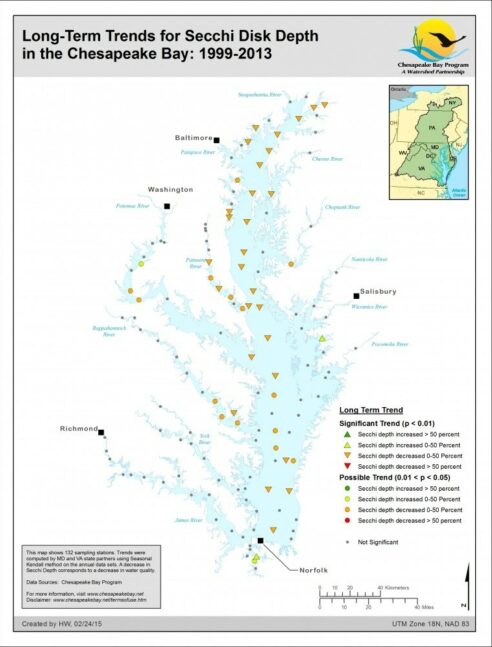Maps
Browse through maps depicting Bay health and restoration, including pollution trends, public access sites and more.
Long-Term Trends for Secchi Disc Depth in the Chesapeake Bay: 1999-2013
Date created: April 30, 2015Long-term trends were computed by state partners using the Seasonal Kendall non-parametric technique for annual data collected from 1999-2013. Highly significant trends are indicated with triangles and possible trends are show with colored circles. Secchi Disk Depth observations (a measure of water clarity) are increasing/improving significantly at 2 stations, possibly increasing at 2 stations, decreasing/degrading significantly at 28 stations, and possibly decreasing at 14 stations.
View map
Long-Term Trends for Bottom Orthophosphate in the Chesapeake Bay: 1999-2013
Date created: April 30, 2015Long-term trends were computed by state partners using the Seasonal Kendall non-parametric technique for annual data collected from 1999-2013. Highly significant trends are indicated with triangles and possible trends are show with colored circles. Bottom Orthophosphate concentrations are decreasing/improving significantly at 21 stations, possibly decreasing at 7 stations, increasing/degrading significantly at 6 stations, and possibly increasing at 3 stations.
View map
Long-Term Trends for Bottom Total Phosphorus in the Chesapeake Bay: 1999-2013
Date created: April 30, 2015Long-term trends were computed by state partners using the Seasonal Kendall non-parametric technique for annual data collected from 1999-2013. Highly significant trends are indicated with triangles and possible trends are show with colored circles. Bottom total phosphorus concentrations are decreasing/improving significantly at 27 stations, possibly decreasing at 13 stations, increasing/degrading significantly at 12 stations, and possibly increasing at 10 stations.
View map
Long-Term Trends for Bottom Total Nitrogen in the Chesapeake Bay: 1999-2013
Date created: April 28, 2015Long-term trends were computed by state partners using the Seasonal Kendall non-parametric technique for annual data collected from 1999-2013. Highly significant trends are indicated with triangles and possible trends are show with colored circles. Bottom total nitrogen concentrations are decreasing/improving significantly at 31 stations, possibly decreasing at 15 stations, and increasing/degrading significantly at 1 station.
View map
Long-Term Trends for Surface Total Phosphorus in the Chesapeake Bay: 1999-2013
Date created: April 28, 2015Long-term trends were computed by state partners using the Seasonal Kendall non-parametric technique for annual data collected from 1999-2013. Highly significant trends are indicated with triangles and possible trends are show with colored circles. Surface total phosphorus concentrations are decreasing/improving significantly at 36 stations, possibly decreasing at 23 stations, increasing/degrading significantly at 2 stations, and possibly increasing at 6 stations.
View map
Long-Term Trends for Surface Orthophosphate in the Chesapeake Bay: 1999-2013
Date created: April 28, 2015Long-term trends were computed by state partners using the Seasonal Kendall non-parametric technique for annual data collected from 1999-2013. Highly significant trends are indicated with triangles and possible trends are show with colored circles. Surface Orthophosphate concentrations are decreasing/improving significantly at 29 stations, possibly decreasing at 7 stations, increasing/degrading significantly at 5 stations, and possibly increasing at 2 stations.
View map
Long-Term Trends for Surface Total Nitrogen in the Chesapeake Bay: 1999-2013
Date created: April 28, 2015Long-term trends were computed by state partners using the Seasonal Kendall non-parametric technique for annual data collected from 1999-2013. Highly significant trends are indicated with triangles and possible trends are show with colored circles. Surface total nitrogen concentrations are decreasing/improving significantly at 41 stations, possibly decreasing at 16 stations, increasing/degrading significantly at 1 station, and possibly increasing at 1 station.
View map
Long-Term Trends for Surface Chlorophyll-a in the Chesapeake Bay: 1999-2013
Date created: April 28, 2015Long-term trends were computed by state partners using the Seasonal Kendall non-parametric technique for annual data collected from 1999-2013. Highly significant trends are indicated with triangles and possible trends are show with colored circles. Surface chlorophyll-a concentrations are decreasing/improving significantly at 2 stations, possibly decreasing at 7 stations, increasing/degrading significantly at 25 stations, and possibly increasing at 16 stations.
View map
